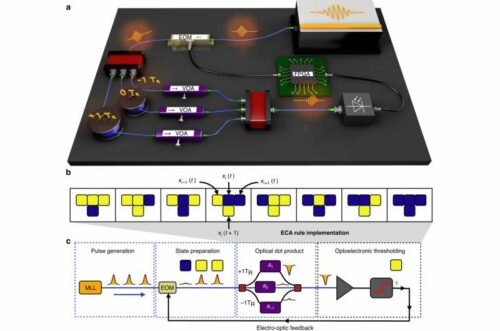Researchers at the California Institute of Technology have used optical hardware for cellular automata, implementing computer models with evolving behaviors in gridded worlds.

The quest for faster, smaller computers has driven manufacturers to design increasingly tiny transistors, now packed by the tens of billions into computer chips. This strategy has yielded powerful computers, but there are limits due to the challenges of manufacturing tiny silicon transistors. To overcome this, researchers explore alternative technologies like quantum computers and photonic computing, which utilizes light instead of electricity, akin to replacing copper wires with fiber optic cables in computer networks.
Researchers at the California Institute of Technology have used optical hardware to implement cellular automata, computer models with gridded worlds where cells exhibit actions and evolve with distinct behaviors. The optical fibers enable faster information transfer compared to copper cables. The researchers focused on utilizing the information capacity of light for computing rather than just communication.
Cellular automata
The hardware design requires comprehension of cellular automata and their functioning. While technically computational models, it is more practical to envision them as simulated cells governed by simple rules. A live cell with fewer than two neighbors dies due to underpopulation, while more than three neighbors result in death due to overcrowding. Cells with two or three neighbors survive to the next generation. Additionally, a dead cell surrounded by exactly three live neighbors comes to life through reproduction. These rules govern the behavior and evolution of cellular automata, giving rise to intricate patterns.
Ideal for photonic computing
The team highlights the suitability of cellular automata for photonic computing due to their local information processing and elimination of complex hardware. Cellular automata interact only with neighboring cells, reducing the need for additional gates, switches, and devices for light-based information movement and storage. Moreover, the high-bandwidth nature of photonic computing enables fast operation of cellular automata. In contrast to traditional computing with multiple language layers, cellular automata operate directly on binary digital information.
A photonic computing device utilizes light pulses as cells, enabling operation at significantly faster speeds than digital computers. The interactions between these light pulses in a hardware grid facilitate on-the-go information processing without the overhead of traditional computing layers. Unlike digital simulations in traditional computers, the device executes real cellular automata. The ultrafast photonic operations and on-chip implementation of photonic cellular automata hold the potential for next-generation computers that outperform digital electronics in efficiency.
Reference: Gordon H. Y. Li et al, Photonic elementary cellular automata for simulation of complex phenomena, Light: Science & Applications (2023). DOI: 10.1038/s41377-023-01180-9





